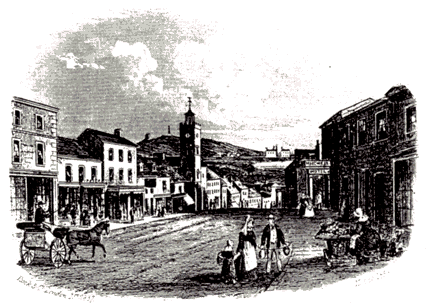|
Home |
 Fore Street, 1858
The town's setting is dominated hy the granite heights of Carn Brea and Carn Marth. Granite is an igneous rock formed from molten material generated at great depth below the surface. Vapours from the granite carried minerals into the rock's fissures before it finally set. In later ages the granite was lifted by earth movements, and exposed to weathering. On Carn Brea can he seen the remains of one of the oldest and largest human settlements in Cornwall, a 46-acre Neolithic hillfort. Minerals were probably worked here since the Bronze Age, and by the Middle Ages mining was well estahlished. Tin was obtained from deposits in the flats of streams the ore faund in material produced by the weakening of veins in the granite. By 1300 streamers were working along the brook that ran along the bottom of Fore Street. The iron oxide from the workings discoloured the water. The red river in turn gave its name to the ford from which the town derives its Cornish name (rhyd= ford, ruth = red). A charter for two weekly markets and two annual fairs was granted in 1324, and the Stannary Courts were sometimes held here in the the later Middle Ages. From Tudor times control of the mining industry passed increasingly into the hands of the gentry, as more costly underground working developed. Map | The Boom Years | About Redruth Town Trail |
